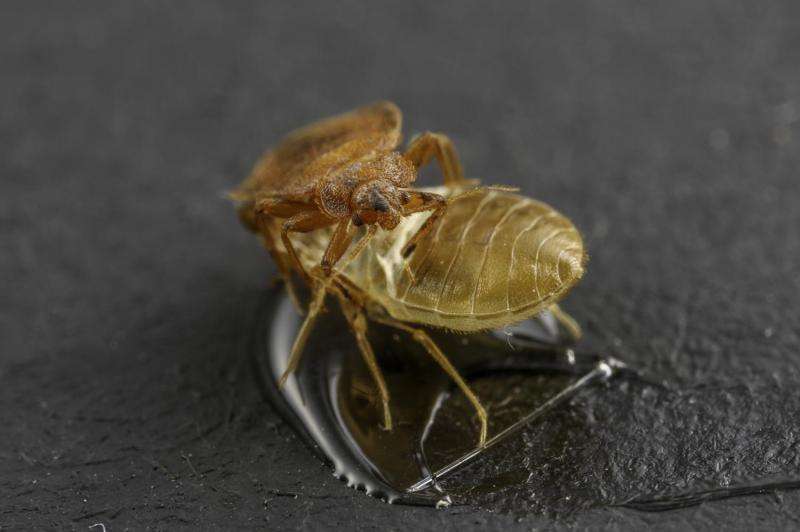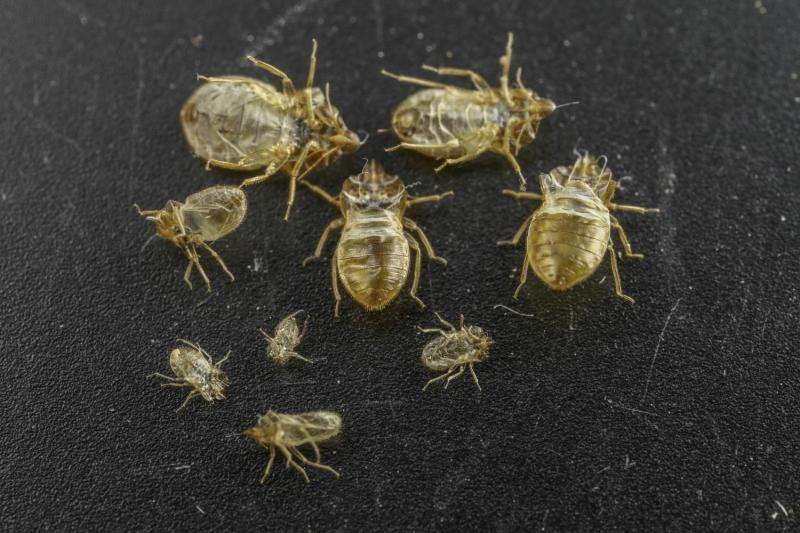Shed skins of bed bugs emit pheromones that could help combat infestations of the insect

Researchers at the University of California, Riverside have discovered the shed skins of bed bugs retain the "obnoxious sweetness" smell often associated with the pests, a finding that could potentially be used to combat infestations of the insects.
Bed bugs shed their skins, known as exuviae, as they grow. Four pheromone compounds known as aldehydes are consistently found in the shed skins.
The UC Riverside researchers found that the shed skins retain those compounds in the glands and gradually dispense them over time. They also found that living bed bugs are likely to settle down in the vicinity of the shed skins by sensing these compounds.
The findings could have significant implications for pest management industries, which can use some of the chemical / mechanical characteristics of the bed bugs' shed skin to develop small, inexpensive monitor traps to catch living bed bugs at their early stages of infestation.
"This could be a key development in the search to find new methods to detect bed bugs," said Dong-Hwan Choe, an assistant professor of entomology and an assistant cooperative extension specialist.
Choe is the lead author of a paper, "Chemically Mediated Arrestment of the Bed Bug, Cimex lectularius, by Volatiles Associated with Exuviae of Conspecifics," published Tuesday (July 19) in the journal PLOS ONE.
Co-authors are Hoeun Park, a former undergraduate student who worked in Choe's lab; Claudia Vo, a current undergraduate student working in Choe's lab; and Alexander Knyshov, a graduate working with Christiane Weirauch, a UC Riverside professor of entomology.

The experimental work outlined in the paper had two stages.
First, the researchers placed shed skins obtained from bed bugs at different points of their development in small vials. They then analyzed the airborne compounds in the vials and found that the four aldehydes of interest were consistently detected regardless of the developmental stage.
Second, they collected shed skins from bed bugs kept in the lab, divided them into three groups and "aged" them in the open air for either seven days, 45 days or 99 days.
Then they crushed the shed skins and analyzed them for the presence of the four aldehyde compounds. They found that the amounts of the aldehyde pheromones dropped as the aging period increased, but that even after 99 days the compounds were still present in the shed skins.
The work had an interesting wrinkle in that researchers could not use carbon dioxide to temporarily knock out the bed bugs when they were handling them. Carbon dioxide gas, which is common in insect research, would have the bed bugs release the large amount of the aldehyde pheromones unnaturally, thus potentially skewing the findings, Choe said.
Instead, they handled active bed bugs.
"That created a level of anxiety," Choe said. "We didn't want to accidentally release any bed bugs in the laboratory. But our students handled it well."
More information: Dong-Hwan Choe et al. Chemically Mediated Arrestment of the Bed Bug, Cimex lectularius, by Volatiles Associated with Exuviae of Conspecifics, PLOS ONE (2016). DOI: 10.1371/journal.pone.0159520
Journal information: PLoS ONE
Provided by University of California - Riverside
















